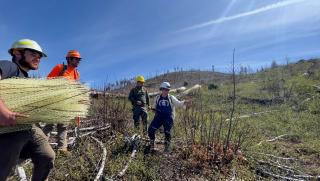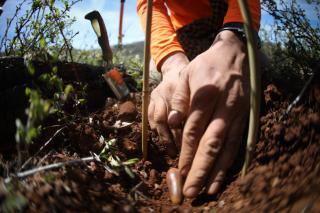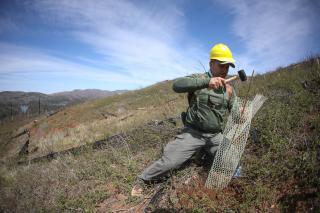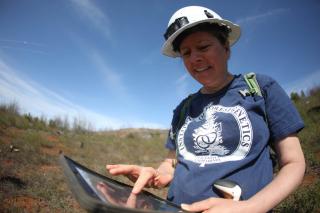Planting trees for tomorrow's climate

CALIFORNIA—With rapid changes in our climate, replanting trees is not as simple as it seems. In post-fire landscapes, it is becoming increasingly important to have both the current and anticipated future climate in mind when choosing what trees to plant and how to plant them. USDA Forest Service researchers and partners are establishing studies to provide land managers with data to inform those decisions.
One such study is contributing to post-fire recovery on the Plumas National Forest in California. This landscape has been hard hit by devastating wildfires in recent years, including the 2018 Camp Fire, which burned through the towns of Paradise and Concow. The Forest Service and partners are restoring this area and mitigating risks of future catastrophic wildfires with the Concow Resilience Project. The project will re-establish widely spaced woodlands—dominated by oak with scattered pines—to more closely resemble how the land looked pre-settlement.
In April, Jessica Wright—a research geneticist with the Forest Service’s Pacific Southwest Research Station—was planting trees in an experimental research plot. She was joined by a Pacific Southwest Research Station ORISE fellow, a partner from American Forests, and a UC Davis student.
“After a fire, a forest often needs to be planted with baby trees. And when that happens the decision has to be made: Where do these seedlings come from?” Wright asked. “We know that trees are adapted to the climate where they grow, but climate change is something that we are seeing, so we've been planting trees into new climates and measuring how they perform.”
When climate changed more slowly, the best practice was to reforest using seeds collected from a habitat with the same climate as the planting site. But now that the climate is changing quickly, research suggests that approach might need to be reconsidered.
Seeds adapted to the present climate of a site may produce saplings that take root in the near-term, then fail in the long-term as temperature continues to rise. But to plant seedlings in a drastically colder environment may mean the next generation suffers cold damage in the near-term and never gets established. How can we plant trees today to be successful while keeping the current and future climate in mind?
That is one of the key questions studies like this seek to answer by using assisted migration. With this climate-adaptation option, seeds are collected from a warmer habitat, taken to a nursery for analysis or to grow into seedlings, then planted in a cooler habitat.
“I'm interested in forest responses to climate change and, specifically, how the choice of seed source could impact the success of a post-fire reforestation project,” said Wright. “Today we have been planting acorns from valley oak, in the burn scar here, into new climates.”
This planting on the Plumas National Forest is similar to what will be done within 20 future plots as part of The Experimental Network for Assisted Migration and Establishment Silviculture.
“I see these as cousin projects. Both studies are trying to ask that same basic question of how different sources of trees perform in post-fire landscapes,” said Wright.
With funding from the Forest Service and American Forests, the Forest Service Pacific Northwest and Pacific Southwest research stations are establishing a network of assisted migration experimental plots. The plots will be established by spring 2024 within forested land of multiple ownerships across California, Oregon and Washington. These experimental sites will test seeds adapted to the current climate and climates of the recent past, mid-century and end-of-century.

Each experimental plot will also use a variety of planting methods—such as reduced density or larger seedlings—to evaluate what might improve short-term survival of seedings and long-term resilience of forests. Deciding which species will be planted and how they are planted will be determined by researchers and the local land manager.
The applied research happening within this network of sites is an example of the Forest Service Reforestation Strategy at work. Climate change is a significant contributing factor to the high-severity wildfires, drought, disease and insect infestations killing our trees.
To address this need, the 2021 Repairing Existing Public Land by Adding Necessary Trees Act, better known as the REPLANT Act, includes a call for the Forest Service to plant 1.2 billion trees over the next decade and provides funding for this work.
The Forest Service will use experimental plots to provide land managers with the latest research results to inform their choices of what and how to plant. The collaboration between research and management will help landscapes recover from the impacts of climate change and become more resilient for tomorrow’s climate.
“Several years ago, I was invited by the then-regional silviculturist to go with him to meet with forests about their reforestation needs. And he told me this is the decision that genetics can inform when we're ordering those seeds. And I took that as a call to action. So here I am,” said Wright.



